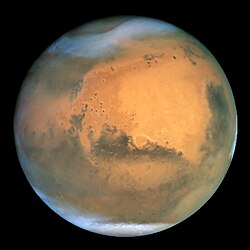Ascraeus Mons
| Den här artikeln behöver källhänvisningar för att kunna verifieras. (2020-10) Åtgärda genom att lägga till pålitliga källor (gärna som fotnoter). Uppgifter utan källhänvisning kan ifrågasättas och tas bort utan att det behöver diskuteras på diskussionssidan. |

Ascraeus Mons är den nordligaste av tre vulkaner (kända som Tharsis Montes) på Mars.
Den är cirka 456 kilometer i diameter[1] och är den näst högsta på Mars på 18.1 km hög. Den skapades av olika utbrott av lava bestående av basalt.[2]
Den upptäcktes av rymdsonden Mariner 9 i Marinerprogrammet år 1971.
Vulkanen fick sitt officiella namn 1973 då man tidigare hade kallat den för "North Spot.[3]

Referenser
- ^ ”Ascraeus Mons”. https://planetarynames.wr.usgs.gov/Feature/417. Läst 2 Februari 2021.
- ^ Mars. Tucson : University of Arizona Press. 1992. ISBN 978-0-8165-1257-7. http://archive.org/details/mars0000unse. Läst 2 februari 2021
- ^ Carr, Michael H. (1973). ”Volcanism on Mars” (på engelska). Journal of Geophysical Research (1896-1977) 78 (20): sid. 4049–4062. doi:. ISSN 2156-2202. Arkiverad från originalet den 18 april 2021. https://web.archive.org/web/20210418035409/https://agupubs.onlinelibrary.wiley.com/doi/abs/10.1029/JB078i020p04049. Läst 2 februari 2021.
| ||||||||||||||||||||||||||||||||||||||||||||||||||||||||
Media som används på denna webbplats
Författare/Upphovsman: Tkgd2007, Licens: CC BY-SA 3.0
A new incarnation of Image:Question_book-3.svg, which was uploaded by user AzaToth. This file is available on the English version of Wikipedia under the filename en:Image:Question book-new.svg
Acraeus Mons (Mars) topography
NASA's Hubble Space Telescope took the picture of Mars on June 26, 2001, when Mars was approximately 68 million kilometers (43 million miles) from Earth — the closest Mars has ever been to Earth since 1988. Hubble can see details as small as 16 kilometers (10 miles) across. The colors have been carefully balanced to give a realistic view of Mars' hues as they might appear through a telescope. Especially striking is the large amount of seasonal dust storm activity seen in this image. One large storm system is churning high above the northern polar cap (top of image), and a smaller dust storm cloud can be seen nearby. Another large dust storm is spilling out of the giant Hellas impact basin in the Southern Hemisphere (lower right).
Map of Tharsis quadrangle on Mars planet, 90° to 135° west longitude and 0° to 30° north latitude. Latin (also international) version.




